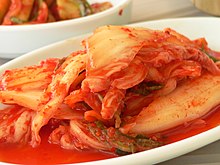There seems to be a lot of interest about Korean food at the moment whether it is because of the current situation between North and South which is giving the country lots of publicity or is it that foodies are looking for a new food experience. There are more Korean restaurants in the USA than the UK which is because of the Korean war in the 1950's when South Korea was supported by the USA.
So what is special about Korean Cuisine ? It is not just Kimchi !
I have taken information from a very interesting article on mostlyfood.co.uk where you can read the whole thing.
Korean Royal Cuisine
A few years ago Korean food was almost unheard of – except in Korea. There were no Korean restaurants and one couldn’t find authentic ingredients even if one could find a recipe. But there has been a burgeoning of restaurants, and one might wonder why.
Korean food fits well with the tastes of the British public. We crave spice but also freshness. We enjoy simply cooked seasonal ingredients. Korean food has much to offer and it’s more available than ever. But what is Korean food?
Korean Royal Court cuisine can be traced back to the palaces of the Joseon Dynasty, which
ruled Korea from 1392 until 1910. Kings were pampered and it was important for them to eat healthy food. They were carried on sedan chairs so they didn’t even have the chance of gentle exercise. Their diet was designed to be low in fat to compensate for physical inactivity.
The king would dine on a dozen different main dishes along with a number of accompanying dishes including two types of cooked rice, two types of soups, three types of kimchi (pickled vegetables), two types of stew, three types of condiments and a steamed dish.
The twelve principal dishes were served on small plates and consisted of cooked vegetables, fresh vegetables, chilled roasted meat or fish, a boiled dish, pickled vegetables, dried meat or fish, salted fish, stir-fried vegetables, and slices of boiled beef; there would also be three special dishes of poached eggs, sashimi, and warm roasted meat or fish.
All these dishes served not only to nourish the monarch but to act as a guide as to how the rest of the country
 was faring: the population was obliged to offer the king the best of their produce. Crops would be harvested, game would be hunted and trapped, and fish would be caught. The quality and quantity of these foodstuffs would be an indication of the health and happiness of the nation.
was faring: the population was obliged to offer the king the best of their produce. Crops would be harvested, game would be hunted and trapped, and fish would be caught. The quality and quantity of these foodstuffs would be an indication of the health and happiness of the nation.A particularly attractive Korean dish gives a hint of the refinement of some of these courtly foods. It’s the Gujeolpan which is the name for the food and what it’s served in.
Gujeolpan or ‘platter of nine delicacies’ is just what the name suggests. It’s traditionally an octagonal lacquered wooden box with eight compartments around the sides and a central compartment. These days they are also made of ceramic and even plastic. The outside sections are filled with cooked vegetables, meats and eggs (with yolk and white separated). The foods are placed so that similarly-coloured items are opposite and this creates a harmonious design when the Gujeolpan is filled.
The centre of the Gujeolpan is reserved for the delicate wheat pancakes (Miljeon-byeong) which are often coloured with pureed vegetables. Each guest takes a little of the prepared foods and fills a pancake. This is rolled or folded and then dipped in sauces before being eaten. The Gujeolpan always looks beautiful and exotic, and even the formality of filling and rolling is appealing.
KIMCHI ( courtesy of Wikipedia)
I cannot leave the cuisine of Korea without talking a bit about Kimchi, The art of lactic fermentation is at the forefront of modern cuisine and is being used by most of the high end restaurants around the world at the moment.
- Kimchi : vegetables (usually cabbage white radish, or cucumber) commonly fermented in a brine of ginger, garlic, green onion and chili pepper. There are endless varieties, and it is served as a side dish or cooked into soups and rice dishes. Koreans traditionally make enough kimchi to last for the entire winter season, although with refrigerators and commercial bottled kimchi this practice has become less common. Kimchi that is readily made is called Gutjaree and the one that is fermented for a long time and has more sour taste is called Shin-Kimchi. Moreover, different regions of Korea make Kimchi in different ways with different kinds of ingredients. For instance the lower southern part tends to make it taste more salty to preserve it longer. Some of the extra ingredients they use include squids, oysters and various other raw seafoods. Kimchiis often cited for its health benefits.Nonetheless, some research has found nitrate and salt levels in Kimchi to be possible risk factors to gastric cancer although shellfish and fruit consumption were found to be protective factors to gastric cancer. Interestingly research has also found kimchi to be a preventive factor to stomach cancer.
- Ggakdugi, radish kimchi
- Baek kimchi, kimchi made without chili pepper
- Mulkimchi, literally water kimchi
- Nabak kimchi
- Dongchimi
- Pakimchi, scallion kimchi
- Buchukimchi, Korean chive kimchi
- Oisobakki, cucumber kimchi
- Kkaetnip kimchi, perllia leaf kimchi
- Chonggak kimchi, kimchi made with pony tail radish
